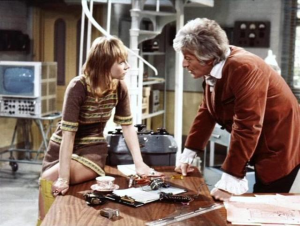The wheel of time turns and much that once seemed shiny, glittering and eternal passes into memory and from there to oblivion. For Hesiod, the passage of time was one of continual decline. From golden age to silver, silver to bronze, bronze to iron. With the new year and new term, the GIS has passed on from the Harrison-Cousins era; though it seems like only yesterday that these columns were filled with their happy bickering, already those times are passing into legend. Thankfully, however, Hesiod has been proven to have not known what he was talking about, for the new Jackson-Boyes* regime brings not decline but EVER INCREASING GLORY!
But not all is change. While the faces of its figureheads change, always two there are. Like the dyad at the top of a Phoenician civic pantheon. Or Dark Lords of the Sith. And the essential GISness of the occasion remains constant. We still have papers, we still have Snippets, we still have the reassuring and enlightening full stop to the week that is the Granta visit, complete with scrabbling around to find sufficient table space.
George Watson opened proceedings this year with a paper entitled ‘Capricorns and Conspiracies: Dating the Eruption of Vesuvius in 79 AD’. George led us through the debates and uncertainties surrounding the date for the eruption that destroyed Pompeii and Herculaneum, highlighting the evidence for and against the traditional Plinian date of 24 August, and explaining how and why several scholars have favoured dates later in the year. From carpets and braziers, through evidence from seasonal fruits preserved in the ash, to the textual transmission of Pliny’s account itself, this was the GIS at its most interdisciplinary and offered much for people from all caucuses to get their teeth into.

The main event, though, was a discussion of the numismatic evidence, and particularly a coin from a hoard in the House of the Golden Bracelet which has recently been claimed to date from Titus’ fifteenth acclamation, and so to suggest a date from the eruption no earlier than August. George showed the many problems with this claim and the wider evidential difficulties with dating these kinds of events using text and archaeology. The discussion which followed was lively and stimulating, and highlighted the shortfall that can often exist between our sense that we need to be able to pin down such major events as the Vesuvius eruption and the often less than satisfactory state of the evidence.
Our Snippet this week came from Bogdan Cristea, who spoke on the debate about Cicero’s views on clausulae as presented in his oratorical treatises. Did he really consider the dactyl as bad as many people have thought? And how much does it matter that his views seem at variance with those of Quintilian? Most of those present seemed persuaded that Cicero considered dactyls to be fine, and agreed that there’s really nothing particularly problematic or surprising about Cicero and Quintilian holding differing views, especially given the amount of time between them.
Finally, Claire, Bogdan and Christina announced their plan to try and bring the Annual Meeting of Postgraduates in Ancient Literature to Cambridge and asked for feedback on possible themes. Three were suggested: ‘Failure’, ‘Homecomings’ and ‘Memory and Oblivion’. The general mood of the room seemed to be that contrary to popular opinion, Failure was very much an option, if only because it would allow Fran to submit a paper entitled ‘Epic Fail’. They’re very interested in getting more views and thoughts on the subject, so for more details or to share your thoughts on what you’d like to see, do get in touch with them.
Afterwards we adjourned to the Granta, as usual, where topics of conversation included how we might better use the media to improve access to and understanding of the research process; modern books, films and TV series about Classical topics, and especially the intersection between Classics and science fiction; and the sexual eccentricities and peccadilloes of the Hittites.
Not unconnected to this last, this week’s award for outstanding achievement in post-seminar discussion goes to Cakemeister Judson for her contribution on ‘gravel’.
* Contrary to first impressions, neither the Harrison Cousins nor the Jackson Boys were mid-20th century pop groups.

